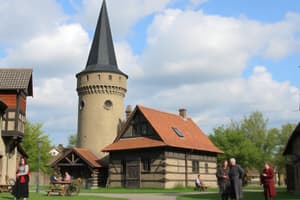Podcast
Questions and Answers
What was the primary economic system in rural areas during the Middle Ages?
What was the primary economic system in rural areas during the Middle Ages?
- Socialism
- Capitalism
- Feudalism
- Manorialism (correct)
Which of the following best describes the role of the Church during the Middle Ages?
Which of the following best describes the role of the Church during the Middle Ages?
- It had no influence on everyday life.
- It acted as a political power and influencer. (correct)
- It isolated itself from societal issues.
- It was focused strictly on spiritual matters.
What defined the class society hierarchy in the Middle Ages?
What defined the class society hierarchy in the Middle Ages?
- Social mobility was unrestricted.
- The division was based solely on wealth.
- It was structured around clergy, nobility, and peasants. (correct)
- Class distinctions were non-existent.
What was a key feature of governance in medieval cities?
What was a key feature of governance in medieval cities?
Why is studying the Middle Ages considered relevant?
Why is studying the Middle Ages considered relevant?
Flashcards
Manorialism
Manorialism
A system of economic and social organization in medieval Europe. Land is owned by a lord and worked by peasants.
Medieval Class Structure
Medieval Class Structure
A hierarchical system in the Middle Ages composed of clergy, nobility, and peasants.
Medieval City Life
Medieval City Life
Characteristics of urban life in the Middle Ages: inhabitants, typical places, and governance. Often self-governed.
Role of the Church
Role of the Church
Signup and view all the flashcards
Medieval Castle
Medieval Castle
Signup and view all the flashcards
Study Notes
European Middle Ages Life Worlds
- The European Middle Ages encompassed a diverse range of life experiences, including cultural interactions, societal structures, economic practices, and religious beliefs.
- The agrarian society of the time was characterized by manorialism, a system of land ownership and labor.
- Rural areas experienced significant changes and advancements during this period.
- Castles played a crucial role in defense and power dynamics of the time.
- Religion and the Church held immense power and influence in shaping societal values and everyday life.
- The Middle Ages exhibited a rigid class structure, comprising clergy, nobility, and peasants.
- Women in the Middle Ages held varying roles and statuses depending on their social class.
- A hereditary monarchy formed the core of medieval political authority in many European regions.
- Medieval cities emerged as centers of trade, commerce, and cultural activity.
- City inhabitants lived in distinctive areas with their specific functions and communities.
- Self-governance aspects were present with governing councils facilitating city administration.
Relevance of Studying the Middle Ages
- Studying the Middle Ages provides essential background for understanding historical context and development.
Studying That Suits You
Use AI to generate personalized quizzes and flashcards to suit your learning preferences.




